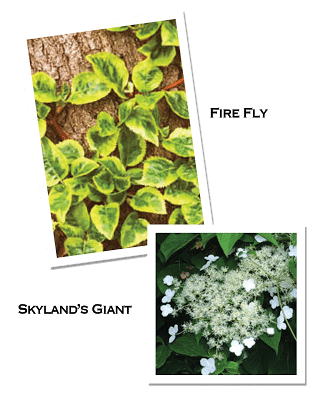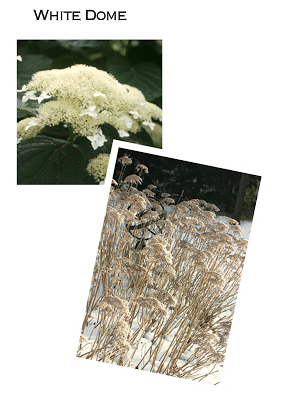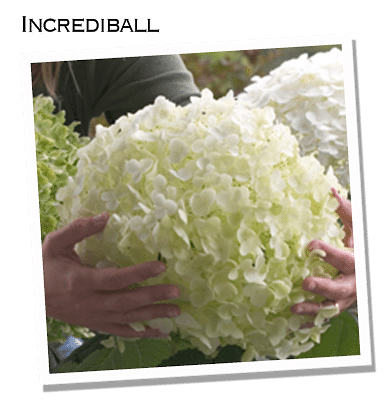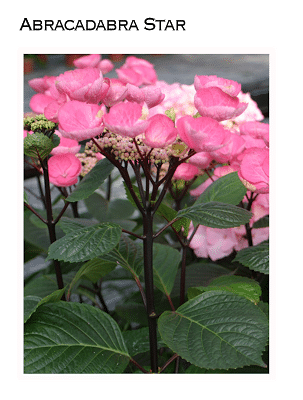T im Wood knows his hydrangeas. This makes perfect sense given that it’s his job to know all about shrubs and hydrangeas might be the most popular shrub there is.
As I mentioned, I went down to the Proven Winners Outdoor Living Extravaganza at the beginning of March. The main focus of the event was four speakers, three of whom had enough great stuff to say that my pen barely stopped taking notes. I should mention here that Proven Winners allowed me to attend the event for free to cover it, but since I’m a journalist in “real” life I take notes on everything, all the time, just out of habit.
Back to Tim. I was really excited about hearing him because I’m nuts about hydrangeas and in his work as Spring Meadow Nursery‘s product development manager Tim has either found (through his network of plant breeders) some of the best hydrangeas around or developed them himself.
This is one of my favorite pictures that I’ve come across on Houzz, taken by Bosworth Hoedemaker. Even though those Annabelle hydrangeas are flopping all over the place (and Tim’s got a solution for that), I love how they are in their chartreuse stage and the whole front of the house is just simple and lovely.
Tim started his talk with the tallest of the hydrangeas: climbing hydrangeas (Hydrangea a. petiolaris). The two newer cultivars that he called out were ‘Skyland’s Giant’, which gets much bigger flowers than the regular old climbing hydrangea and ‘Fire Fly’ which is a beautiful variegated-leafed variety. Fire Fly was beautiful in the pictures, but two things probably make it one that I wouldn’t choose for my own garden: variegated plants tend to grow slower than non-variegated varieties. Climbing hydrangeas are notoriously slow to establish themselves and I’m not sure I could stand to wait any longer than I already do. Also, the variegation is best in spring and by summer the leaves will be mostly green, and it’s less free-flowering than others so you’re giving up blooms for those leaves.
Then Tim moved onto my favorite kind of hydrangeas: Hydrangea arborescens, which what I think most people think of when they hear “hydrangea.” Annabelle, which is featured in that photo above, is the most popular hydrangea in the world, Wood said. But it’s not without it’s faults, one of which I’ve already mentioned, which is it’s propensity to flop. I have mine caged about three feet up yet it still manages to flop over.
An outstanding cultivar in this type is ‘White Dome,’ which is a lacecap variety. I will admit that I’m like most gardeners and greedy for big blooms so I’ve overlooked the lacecaps in the past. What’s good about White Dome is that it has very sturdy stems that never flop and nice big, clean leaves. What sold me on this plant was a photo of it in winter. You know how they always talk about “winter interest?” Well, let me tell you, White Dome in winter is the very definition of that.
It didn’t take long for someone to figure that crossing White Dome and Annabelle might be a good idea and alas Incrediball was born. If you’ve been following this blog for any amount of time you know about Incrediball because I’ve been talking about it since last year, and you know there will be more than a few heading to my garden this year.
Along the same lines as Incrediball is another Annabelle cross called Invincibelle Spirit. This new one boasts the same strong stems as Incrediball but the flowers are smaller than Annabelle’s and in a pretty pink hue. Most outstanding about this hydrangea, in my opinion, is that $1 from the purchase of each Invincibelle Spirit hydrangea goes to breast cancer research.
Then Wood moved onto hydrangea macrophylla Bigleaf hydrangea, and here’s where it gets excited. This is the group of hydrangeas that blooms on old and new wood. It’s no secret that I’m not a fan of Endless Summer, which falls in this group, so it made me happy to hear Wood confirm that it is “undependable” at least when it comes to reblooming. But there’s exciting news in this category.
Yep, black stems, which leaves set far apart so you can see them. Then top it off with pink blooms. It’s called Abracadabra Star and it’s fantastic. It will take more work for those of us in the northern zones because it will be important to try to protect the “old” buds (burlap stuffed with oodles of leaves works pretty well).
For people who are in love with the idea of Endless Summer but, like me, disappointed in its performance, the Let’s Dance series might be the ticket. Wood especially suggestion Let’s Dance Moonlight because it reblooms faster.
A few quick notes from Wood on this time of hydrangea: prune them before mid-July so you aren’t pruning off the next year’s blooms and cut the steams that don’t have flowers as low to the ground as possible.
There’s also exciting things happening in the hydrangea paniculata category, in which one of my faves—Limelight—resides. Limelight is great (so great that Wood said they sometimes receive pictures from people who have Limelight-themed weddings) but it can get big (10 feet). Have no fear, Wood himself is bringing a little gem called “Little Lime” to the market in the next year or two. It will be one-quarter the size of Limelight and I can guarantee you there will be more than a few of those in my garden.
Quick Fire is another variety in this category that Wood said he likes (and an audience member backed him up). It’s bred to bloom very early and it’s blossoms turn pink much earlier and has a relatively compact habit. Sounds like one to check out.
One other quick note Limelight: if you haven’t already pruned yours for size this year, then do it … quick. Wood says they cut theirs at the nursery (where they use them as a hedge) by half at least.
Wood left with one last hydrangea tip (one that I can certainly use): Be patient. You need to dedicate at least the first year or two of a hydrangea’s life to building the plant. So that means pinch it back to create good, strong branching and don’t get greedy for blooms right away. I know … easier said than done.
You can follow Tim Wood’s plant hunting adventures at his blog.
Hydrangea photos from Spring Meadow Nursery







5 Responses
Well you won't get in trouble with me, Eric, but I can't be responsible for what happens if your mom finds out. Seriously, though, I bet the lawn looked awfully pretty with all those little petals strewn about.
I'm sure I'll get in trouble for saying this, but – When my brother and I were kids, my mom had a hydrangea right outside the back door.
We would pick the big bushy flowers, and leave the long stem attached.
Then fight each other, using the flowers at the end of the stalks as swords. You could always see where we battled from the tiny petals that would litter the lawn.
Wow I never knew so much about hydrangeas! I love the pic of the incredibal! WOW! that is gorgeous!
Love and adore hydrangeas! Especially the big white ones!
Great post — thank you! I love the white ones!